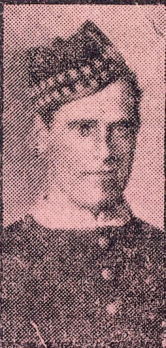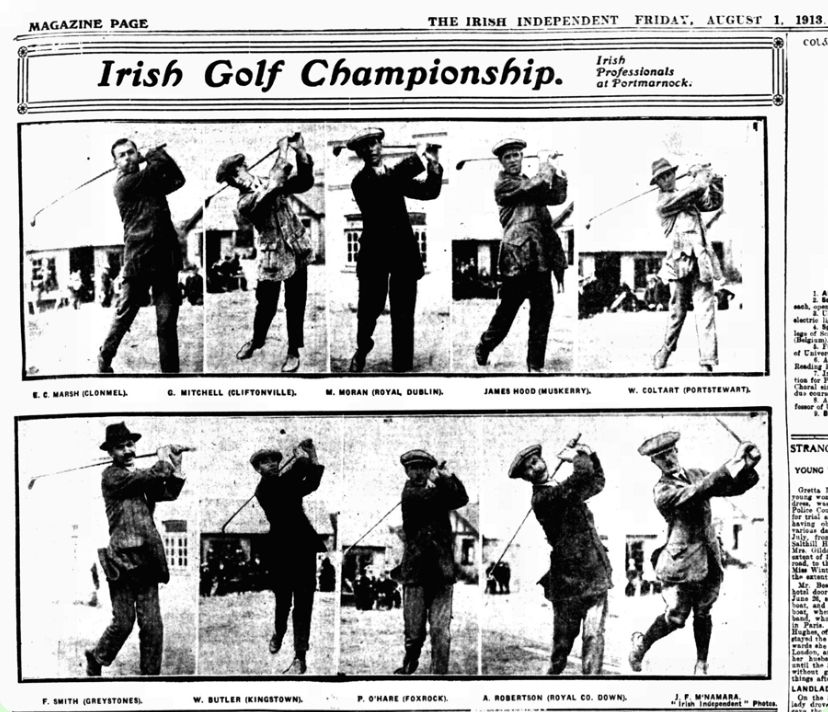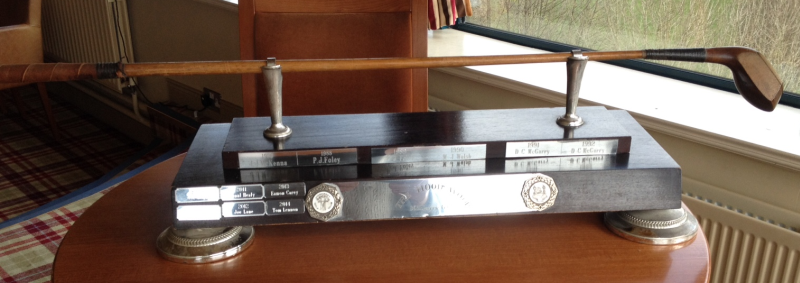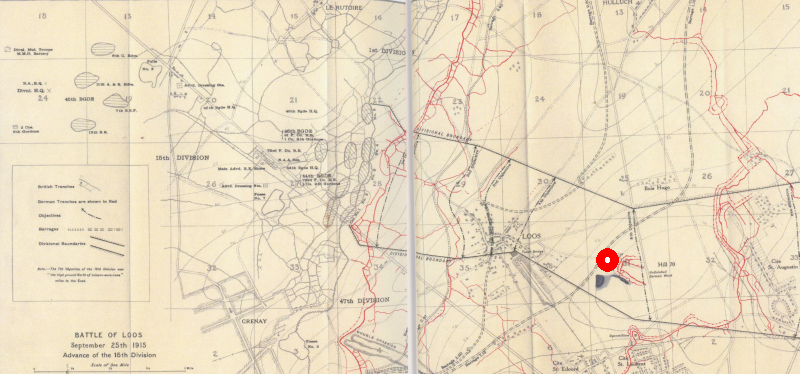 PTE JAMES HOOD 7TH R.S.F.
PTE JAMES HOOD 7TH R.S.F.
13024 Private James Hood
7th Battalion, Royal Scots Fusiliers
died of wounds 30th October 1915
aged 26
St Machar's Church Memorial, Bridge of Weir
Kilbarchan Cemetery
Son of John Hood and Janet Whyte
Clachan Buildings, Bridge of Weir
His Life
James Hood was born on 20th February 1889 in Bridge of Weir, one of a family of seven born to John Hood and Janet Whyte, both from Bridge of Weir, who had married there on 27th April 1877.
In 1881 John (27), Janet (25), and their first two children John and George were living in Boghead, Beith, Ayrshire where John was a currier.
In 1891 the Hood family of five including young James (2) had moved to Patrick's Land, Bridge of Weir. John was a currier and there were two boarders living with the family, Alex Liddle and Hugh Mangwall. John junior was no longer with the family.
In 1901 eight of the Hood family were in Blackbull Buildings, Bridge of Weir. John was still a currier, George was a plumber, Jessie a laundress, and Alexander was an apprentice joiner. The three younger children including James (12) were at school. William was no longer in the family home.
James became a professional golfer at St Andrews, while working as a golf club maker. In 1911, aged 22, he was boarding in the family home of William Fairful, also a golf club maker, in Glamis Road, Kinghorn, Fife. He enjoyed success in his time at St. Andrews, finishing third in the Scottish Professional Championship in 1911.
In 1912 he became Professional at the Muskerry Golf Club in County Cork, Ireland.
 He competed in the Irish Professional Golf Championship in July/August 1913 at Portmarnock.
He competed in the Irish Professional Golf Championship in July/August 1913 at Portmarnock.
He was employed at Muskerry until the club's financial position forced them to dispense with his services, with regret, with three months' notice from 9th May 1914.
 The Cork Muskerry Club still competes for "The Hood Wood" trophy - incorporating a club probably made by James.
The Cork Muskerry Club still competes for "The Hood Wood" trophy - incorporating a club probably made by James.
By the time he served his notice, war had been declared and James returned to Scotland and volunteered. He joined the 7th Battalion of the Royal Scots Fusiliers in September 1914, part of Kitchener's Second Army of volunteers (K2). He later won a golf competition at Aldershot which was open to all enlisted men in his Brigade.
Private Hood first joined the theatre of war on 10th July 1915 in France. His battalion came under orders of 45th Brigade, 15th (Scottish) Division which took part in the Battle of Loos. He was wounded on 25th September 1915, the first day of the advance on Loos, and he was repatriated to the Old Mill Hospital in Aberdeen.
Shrapnel had forced bits of his uniform into his chest and right arm. Medical staff progressively removed pieces of cloth and metal from his wounds but by the end of October a haemorrhage was identified from the lacerated arteries in his right arm. On 30th October the arm was amputated but James Hood never recovered from the operation. He died with one of his sisters at his bedside.
His body was transported to Bridge of Weir for his funeral and burial in Kilbarchan Cemetery, officiated by Rev. A.M. Shand. His coffin was born on the shoulders of soldiers with hundreds of people lining the streets of Bridge of Weir. A detachment of Royal Scots Fusiliers came from Greenock and a pipe band with muffled drums played the Dead March.
Less than three months later his older brother Alexander enlisted in January 1916 and joined the Royal Engineers.
 The 15th Dvision's advance on 25th September 1915, the first day of the Battle of Loos. The furthest advance of the 7th Royal Scots Fusiliers is shown by the red circle. James Hood received his ultimately fatal wounds that day.
The 15th Dvision's advance on 25th September 1915, the first day of the Battle of Loos. The furthest advance of the 7th Royal Scots Fusiliers is shown by the red circle. James Hood received his ultimately fatal wounds that day.
Siblings
| 1881 Census | 1891 Census | 1901 Census | 1911 Census | Birthplace | ||||
|---|---|---|---|---|---|---|---|---|
| Name | Age | Name | Age | Name | Age | Name | Age | |
| John | 3 | Beith, Ayrshire | ||||||
| George | 1 | George | 11 | George | 21 | Beith, Ayrshire | ||
| William | 9 | Beith, Ayrshire | ||||||
| Janet F | 7 | Jessie | 17 | Bridge of Weir | ||||
| Alexander | 5 | Alexander | 15 | Bridge of Weir | ||||
| James | 2 | James | 12 | James* | 22 | Bridge of Weir | ||
| Annie | 8 | Bridge of Weir | ||||||
| Nellie | 6 | Bridge of Weir |
* = not in John and Janet Hood's family home - see text for details
Sources
- Commonwealth War Graves Commission
- Scottish National War Memorial
- James Hood birth certificate, 20th Feb. 1889. Regd. Kilbarchan, Renfrewshire 11th March 1889.
- 1881 UK Census: Parish: Beith; ED:2; Page:13; Line:14; Roll: cssct1881_180.
- 1891 UK Census: Parish: Kilbarchan; ED:8; Page:6; Line:10; Roll: CSSCT1891_185.
- 1901 UK Census: Parish: Kilbarchan; ED:2; Page:5; Line:16; Roll: CSSCT1901_188.
- 1911 UK Census:Parish: Kinghorn Burghal; Page 11; Line 31: 439/00 003/00 011.
- The Courier:
o 22nd February 1912: ST ANDREWS PROFESSIONAL RECEIVES APPOINTMENT: James Hood, a member of St Andrews Club, has been appointed professional to the Mushkerry [sic] Club, Cork. Hood plays a strong game, as was evidenced not long ago, when he took third place in the Scottish Professional Championship. - Cork Muskerry Golf Club Minutes
- 19th Feb 1912; Trinity Chambers, Cork: Present: F.W. Mahony (in the chair) F.F. McCarthy, W.J. O'Hara (Hon. Sec.). The appointment of James Hood as professional to the club at £1 per week & his profits on sale of balls and clubs, also lessons, was ratified.
- 9th May 1914; Club House: Present: Sir Geo. Colthurst, in the chair, E.W. Barnes, Col. Nicolls, Dr Ryan, F.H. Sutton, F.W. Mahony. The Hon Treasurer having represented to the Committee that it would be advisable to dispense with the services of James Hood professional for financial reasons only, the Committee being very well pleased with him -: it was resolved - That James Hood be given notice to leave of 3 months, - Hood was called in & informed of the decision & of the reasons for it & the Committee expressed regret at parting with him & promised him the highest recommendation. Hood thanked the Committee.
- Paisley and Renfrewshire Gazette
- 12th September 1914: Recruited. James Hood. Professional Golfer
- 5th December 1914: Roll of Honour: Royal Scots Fusilier: Peter Higgins, Cameron Place, James Hood, Clachan Buildings.
- 9th October 1915: Mrs Hood residing at Clachan Buildings has received a letter from the front stating that her son James has been wounded in the right arm and is now on his way home. He was engaged in a recent battle when the Royal Scots Fusiliers held the day and took a town, besides capturing Hill 70
- 15th October 1915: He was also wounded in the chest and is at present lying in Aberdeen Hospital and progressing slowly.
- 30th October 1915: Private James Hood has had to have his right arm amputated. It appears that the shrapnel had forced a piece of his tunic, and bits were removed from time to time. Latterly haemorrhage set in from the lacerated arteries and so the arm had to be taken off.
-
5th November 1915: A TRIBUTE TO THE MEMORY OF JAMES HOOD:
"He did his little bit."
Not in the field of sport he won his fame,
But in the crash of war, the greater game;
Scorning the life of ease he might have led,
He chose the patriot's rugged path instead.
Unlike the foe who slighted warfare's laws,
Fairly he fought, nor shamed his noble cause,
And, counting honour more than wordly gain,
Dying for honour, he has not died in vain.
Sacred the spot where now the hero lies,
Sacred the memory of his sacrifice;
Not only now, 'mid death and sorrow grim,
But in the years to come, we will remember him.
AN OLD CHUM.
WOUNDED SOLDIER'S DEATH. MILITARY FUNERAL. Great sorrow was felt in the village last Monday when the news came that Private James Hood, 7th Royal Scots Fusiliers, had died in the Old Mill Hospital, Aberdeen, on the 30th October, from wounds received at the battle of Loos. As a private in Kitchener's Army, he joined the war at its beginning in the month of August, and had seen a good deal of active service until he was wounded in the chest and arm last September. After a brief illness he succumbed to his wounds in the hospital in Aberdeen, one of his sisters being present at his passing away. The body was conveyed to Bridge of Weir last Monday night, when a most impressive scene took place as the coffin was borne on the shoulders of soldiers to his parents' home. Several hundreds of people followed the remains on its sad journey, the procession being loyally headed by the Rev. A. M. Shand, who, along with his sisters, have been very kind throughout the bereavement. The funeral was on Wednesday, when a detachment of the Royal Scots Fusiliers came from Greenock to pay tribute to their comrade's heroic death. A large crowd assembled on the main streets, and window blinds were reverently lowered as the hearse, with the coffin wrapped in a Union Jack, proceeded through the village to the Kilbarchan Cemetery. The mourners included friends from near and far, and were led by a pipe band and muffled drums playing the Dead March. At the grave the Rev. A. M. Shand officiated, and spoke touchingly of the one who had fallen in battle for his country. Private Hood was well known in the village as a professional golfer, and in this capacity distinguished himself both at St. Andrews and at Cork Muskerry Golf Club, where he was professional until he joined the Army. One of his greatest achievements in the golfing world was when, as a soldier at Aldershot, he won the first prize in the open competition to all non-commissioned officers and men in the Brigade, a Belgian officer winning the second prize. Deceased was only 26 years of age, and was a young man of good physique and amiable character. His parents and brothers and sisters reside at the Clachan-buildings, for whom much sympathy is felt throughout the village. - 15th January 1916: Another name to be added to the local list of recruits is Sapper A Hood Royal Engineer. His brother James died of wounds received at the Battle of Loos.
- Glasgow Evening Times:
o 4th November 1915: Private James Hood, 7th Royal Scots Fusiliers, died in the Old Mill Hospital Aberdeen, from wounds received at the battle of Loos. He was professional to the Cork Muskerry Golf Club and won the first prize at the open competition for professionals at Aldershot. He was the youngest son of John Hood, Clachan Buildings, Bridge of Weir. - Cork Examiner:
o Deaths: 6th November 1915: In 1912 James Hood, St Andrews, was appointed club professional but, due to financial constraints within the club, he departed in May 1914. He saw World War action after that with the Royal Scots Fusiliers and died of wounds received in action in France in October 1915. - The Fifteenth (Scottish) Division 1914-1919. J. Stewart and John Buchan. 1926.
- At 8.30 A.M. [25 September 1915] the situation was as follows:-
On the right, the 47th Division had captured the German front-line system from the Double Crassier to Loos Cemetery, and were in touch with the 7th Cameron Highlanders, whose commanding officer, writing from Loos Church, reported the village full of men of the 44th and some of the 45th Brigades. The leading lines of the 44th and 46th Brigades were then advancing up the slopes of Hill 70. and the 45th Brigade in Divisional reserve occupied the original British front line, with the exception of two companies of the 7th Royal Scots Fusiliers, who, owing to a mistaken order, had followed the 44th Brigade into Loos. - Loos, 9 A.M.-10 A.M.: ...By the time Colonel Sandilands (7th Camerons), accompanied by the two companies of the 7th Royal Scots Fusiliers, under Major Campbell, who had followed the 44th Brigade into Loos, arrived at the scene. Seeing that all attempts to hold the redoubt [on Hill 70] had failed, he gave orders to consolidate and dig in on a line just below the western crest of the hill.
- Loos, 12 noon. 45th Brigade sent up: ... About noon, General McCracken ordered the 45th Brigade to Loos to hold it. By noon, all troops of the Division were engaged, and the only reserves at General McCracken's disposal were the 9th Gordons (Pioneers), less two companies, and machine-gun sections (who had accompanied the assaulting columns), and the Divisional mounted troops.
- While this was going on, the left of the 46th Brigade was still in the air. The 7th K.O.S.B. had sent out numerous patrols to ascertain the whereabouts of the 2nd Brigade. No trace of it could be found, and at 10.15 A.M., in response to requests for reinforcements, General McCracken sent up the 6th Camerons (Lieut.-Colonel Douglas Hamilton) from the 45th Brigade to cover the left of the 46th. He also ordered the 7th Royal Scots Fusiliers (45th Brigade) to move into the third German trench line. It was then discovered they had already gone forward. They were therefore told not to proceed farther than Hill 70, and put under the orders of General Wilkinson (44th Brigade).
- So far all had gone well; the losses had certainly been heavy but if fresh troops arrived, there was no reason why the victorious career of the Fifteenth Division should not have continued.
- At 6 P.M. what remained of the 44th and 46th Brigades were well-nigh exhausted. They had fought continuously for twelve hours, had penetrated four German lines to a depth of over 3000 yards, and had lost about 75 per cent of their fighting strength. General McCracken decided to withdraw the 44th Brigade into Divisional reserve behind Loos, and instructed the 62nd Brigade to place one battalion at the disposal of General Matheson (46th Brigade), and to hold the remainder in support of the 45th and 46th Brigades about Puits 15, just east of Loos. He directed the 45th to take over the defence of Hill 70 from the 44th, and placed Lieut.-Colonel MacLear (13th Royal Scots) in command of all the troops on Hill 70.....The situation at dusk was therefore as follows: The crest of Hill 70 and the redoubt on it were in the hands of the enemy. A mixture of troops of the 44th, 45th, and 46th Brigades were entrenching themselves just below the crest.
- Loos, 9.45 P.M. 45th Brigade take over defence of Hill 70: The 45th Brigade was now disposed as follows: 7th Battalion Royal Scots Fusiliers on the right; 13th Battalion Royal Scots, centre; and 11th Battalion A. & S. Highlanders on the left, in touch with the 2nd Brigade, the 6th Battalion Cameron Highlanders being still under the 46th Brigade.
- Until midnight, the enemy actively shelled Hill 70, its western slopes, and Loos village, and at 12.30 A.M. delivered a counter-attack against the 7th Royal Scots Fusiliers on the right of the line. This was easily repulsed, and for the remainder of the night fire slackened on both sides.
- War Diary: 7th Royal Scots Fusiliers. 5 July 1915- 5 May 1916. National Archives WO95/1947/1.
- VAUDRICOURT. 23/9: Marched to VAUDRICOURT and bivouacked in Chateau grounds. Very wet night.
- 24/9: Left for trenches at 9 pm, marched to GRENAY line and rested. The front line of attack left the trenches at 5.50 am.
- 25/9: Left GRENAY line at 4 am & wormed up ammunition trench. Southern up and formed up in trenches left by 10th Gordons 8 am. Head Quarters at Quality Street - At 9 am the battalion advanced on LOOS and meeting with little or no opposition it reached LOOS village about 10 am. LOOS was cleared and heavy fighting then began for the occupation of Hill 70 beyond it. The Battalion established itself near the west and dug in. Units being much messed up. The enemy counter-attacked during the night but were repulsed with loss.
- 26/9: At 7.30 am orders received that 45th Bde. would attack at 9 am preceded by 1 hour's bombardment on the Redoubt. This was carried out but owing to the fatigue of the troops and the mixture of units this was unsuccessful. The Battalion held on to its trenches facing the enemy till 5 pm when they retired & were relieved by the 6th Cavalry Bde. During the day two unsuccessful attacks were made by the 21st Division to join up with our left flank. Casualties during the two days fighting were: Killed 6 officers 63 men: wounded 12 officers 246 men. Missing 1 officer & 80 men. Men rested that night at Quality Street.
- St Machar's Church of Scotland Death and Interment Register:
o Hood, James; Private Royal Scots Fusiliers; Clachan Buildings; Died Oct. 30 of wounds at Loos on 25th Sept.; Buried Kilbarchan Cemetery 3rd Nov 1915; aged 26 Died at Old Mill. - Kilbarchan Cemetery Monumental Inscription:
o 13024 Private J. HOOD Royal Scots Fusiliers 30th Oct. 1915 aged 26. 'A good soldier of Jesus Christ'. (to the left and fallen) JOHN HOOD died 4th Jan 1940 aged 66 years from the employees Gryfe Tannery Ltd. - Medals: Victory, British War, 1914-15 Star
TO CITE THIS PAGE: MLA style: "Bridge of Weir Memorial". Date of viewing. http://www.bridgeofweirmemorial.org/profile-hoodjames.html

